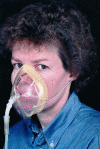ABC of oxygen. Acute oxygen therapy
- PMID: 9740573
- PMCID: PMC1113909
- DOI: 10.1136/bmj.317.7161.798
ABC of oxygen. Acute oxygen therapy
Figures








Comment in
-
Audit of oxygen prescribing. Treatment needs to be adjusted.BMJ. 2001 Mar 31;322(7289):799. BMJ. 2001. PMID: 11303534 Free PMC article. No abstract available.
Publication types
MeSH terms
Substances
LinkOut - more resources
Full Text Sources
Other Literature Sources
Medical
